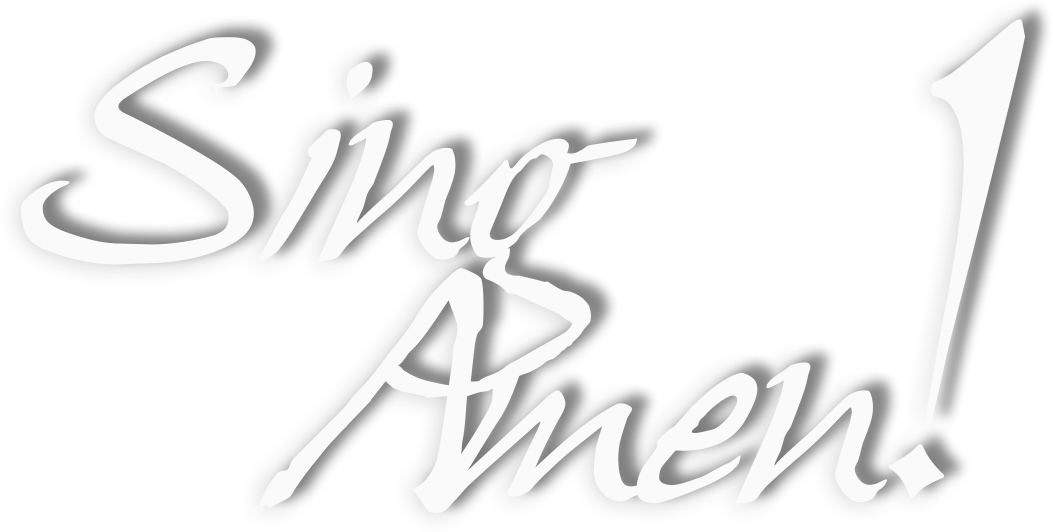Ministering through Music
Keyboard to Keyboard
¡Cantemos Amén!
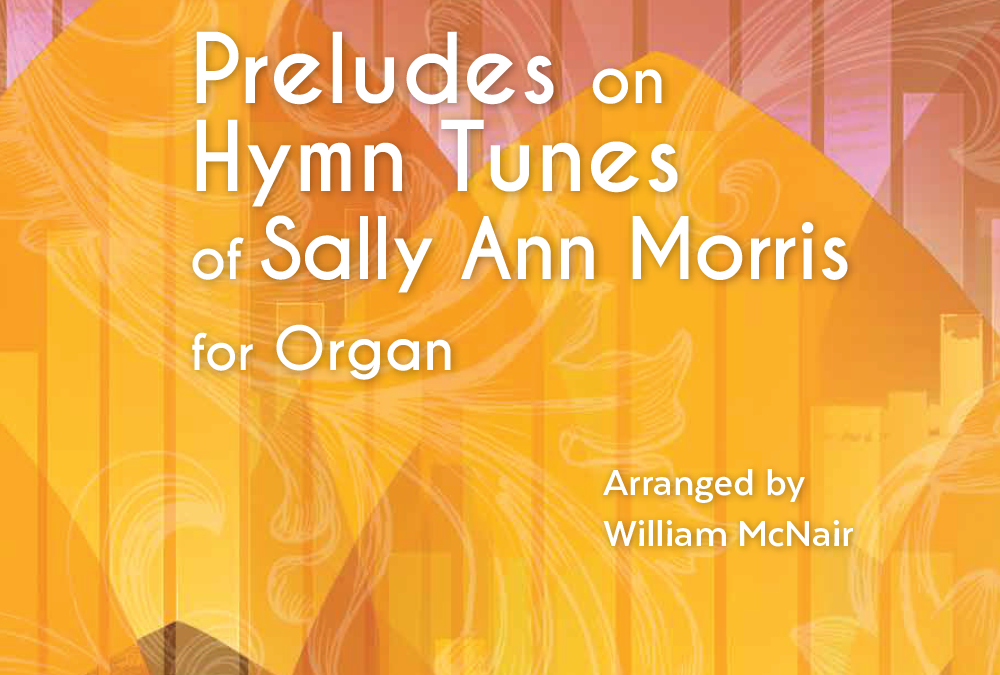
Piano and Organ Music to celebrate Women’s History Month
Women’s History Month is celebrated during the month of March in the United States, the United Kingdom, and Australia, corresponding with International Women’s Day (March 8). The goal is to highlight the contributions of women in society through history and well as present day.
Some of the most well-known female composers throughout the centuries are listed here, beginning with Hildegard von Bingen (1098-1179) and including 21 women from Hildegard to Phamie Gow (b. 1980). These women have made outstanding contributions to the world of concert music. If you are looking for music by women for sacred liturgies, however, their music might not be the quickest place to begin, although careful searches will reveal much literature to enrich and broaden your library.
Consider supporting the following women (as well as all current composers), by adding their music to your library. The following list includes music written by women that is currently available from GIA and WLP.
GIA Organ Music by Women Composers
Ninety Easy Hymn Accompaniments for Keyboard by Margaret Mealy
An Easter Fanfare by Carla Giomo
Hymn Intonations by Carla Giomo
Sing a New Song to the Lord by Anne Roberts
Six Hymntune Sketches for Organ by Anne Roberts
Sondra Tucker has a number of titles with GIA, so to find all of her available music (for handbells and choir as well as for organ), do a composer search.
One in Love and Peace is a collection of wedding music for piano, organ and optional instruments edited by Kelly Dobbs-Mickus and Bob Moore. Essential for anyone’s music library!
Four Festive Pieces for Organ edited by Eurydice Osterman
Ten Hymn Settings for Organ, Volume 1 and Volume 2 by Marilyn Biery (yours truly!)
GIA Piano Music by Women Composers
Jeanne Cotter is another composer whose compositions and offerings are sizeable, so please search for her music by her name, as well as for Ann Buys, who also has multiple entries.
Kathleen Basi has a collection for flute and piano, Times and Seasons. Basi has a second collection for flute and piano: A Walk in the Woods.
Simple Gifts by Kathy Henson is a collection of easy hymns and songs for piano.
As most of you know by now, GIA and WLP have formed a new partnership, and the WLP catalog is in the process of being transferred to GIA’s website. The following list of pieces was given to me by Alan Hommerding, Liturgy Publications Editor for GIA/WLP. The transfer of editions is still in process, so many of those linked below do not, as yet, have a detailed listing of what is in each volume.
WLP Organ Music by Women Composers
Consoliere Classic, Volume 1
Monastic Meditation / Sr. Edith Scholl, OCSO
Consoliere Classic, Volume 2
Christus Vincit / Sr. Mary David Callahan, OSB
Ave Verum / Sr. Mary David Callahan, OSB
Salve Mater / Sr. Mary David Callahan, OSB
Ave Maria / Sr. Mary David Callahan, OSB
Variations on “Puer Nobis” / Tannis Grimes
Consoliere Classic, Volume 5
Ubi Caritas et Amor / Mary Beth Bennett
Consoliere Classic, Volume 6
Prelude on “Lobe den Herren” / Emma Lou Diemer
Bridging the Centuries (The San Diego AGO Anthology)
Chaconne and Toccata on “King’s Weston” / Mary Beth Bennett
Aria la Romanesca / Kathleen Scheide
Tango Toccata on a theme of Melchior Vulpius / Pamela Decker
Prelude on “Lobe den Herren” / Emma Lou Diemer
The ChicAGO Centenary Anthology
Sonata No. 2 (IV. Toccata) / Lily Wadhams Moline
In Quiet Mood / Florence B. Price
Feet Don’t Fail Me Now! Vol. 1 (Advent/Christmas)
Variations on “Puer Nobis / Tannis Grimes
Feet Don’t Fail Me Now! Vol. 2 (Lent/Easter)
Christus Vincit / Sr. Mary David Callahan, OSB
WLP Piano Music by Women Composers
For the Beauty of the Earth
Lord, Whose Love in Humble Service / Laura Kutscher
God, We Praise You / Laura Kutscher
Play for the Lord, Volume 6 (Piano Duets) / Teresa Cobarrubia Yoder
Come to the Manger / Kathleen Basi
This Joyful Eastertide / Kathleen Basi
GIA has a number of fabulous women on their staff as well as contributors in other genres. Please celebrate these amazing women, and keep an eye out for their contributions!
Carol Browning
Jennifer Kerr Budziak (the editor of Sing Amen!)
Sally Ann Morris (see featured image, above, for a collection that features arrangements of her hymn tunes)
Mel Bringle
Lori True
Bex Gaunt
Jacque Jones
Diana Macalintal
Kathy Powell
Bridget Jankowski
Lisa Marsh
Barbara Conable
Diana Kodner Gokce
Kate Williams
Special thanks to Victoria Zibell, Associate Sacred Music Editor at GIA, for being such a helpful resource for me in this blog, as well as in all things GIA!
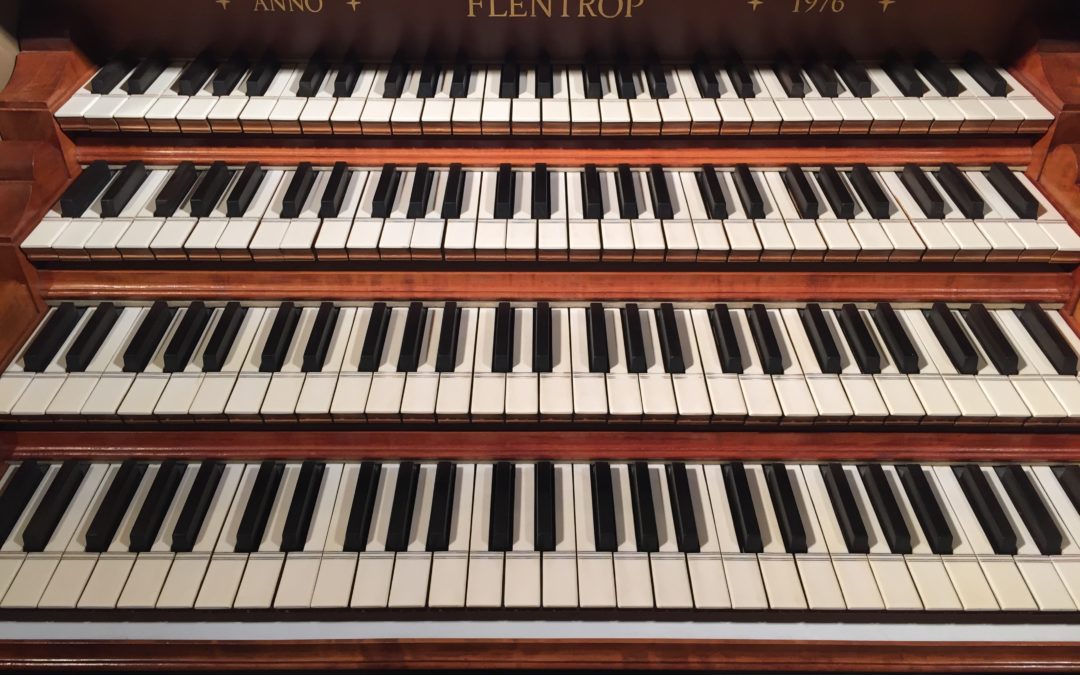
Organ Music for Black History Month and Every Month
Since moving to Detroit, I have served in several churches with members that represented many different ethnic backgrounds. It became a much-anticipated tradition for me to highlight Black History month through music as well as other artistic creations, and I looked forward to that month every year, using spiritual solos and arrangements as well as organ preludes and postludes. It seems to me to be significant to mark the month with tributes that are heartfelt and joyous, as well as to be sure that music of all people is represented throughout the year.
So if you are still looking for some organ music to use this month of February, here are some ideas. And if you are looking for some wonderful repertoire by African American composers to use at any time of the year, the best place to start is GIA’s three volume set, King of Kings, Volumes 1-3, Organ Music of Black Composers, Past and Present, Compiled and Edited by James Abbington.
I’ve been using Volumes 1 and 2 for a number of years now, and the following are some of my favorite pieces. In the first volume, Retrospection by Florence B. Price (ca. 1887-1953), and three pieces by Samuel Coleridge-Taylor (1875-1912), Arietta, Melody, and Elegy.
Florence B. Price was born in Little Rock, Arkansas and died in Chicago, IL. She was the first black woman to have a symphony performed by a professional orchestra, the Chicago Symphony Orchestra. Her catalog is large and includes symphonies, chamber music and choral works as well as music for organ and piano.
Samuel Coleridge-Taylor was an English composer, born in London to an English woman and a Sierra Leone Creole physician. They were not married, so his mother, Alice, raised him in her father’s household. Samuel achieved a great deal of success and was referred to as the “African Mahler” by white New York musicians after three tours of the US in the early 1900s. Coleridge-Taylor died of pneumonia at the age of 37, an illness often attributed to stress regarding his financial situation. After his death, King George V bestowed an annual pension on his widow, demonstrating the high esteem in which Coleridge-Taylor was held.
The second volume includes three more pieces by Florence B. Price: Adoration, A Pleasant Thought, and In Quiet Mood. There is also an Impromptu by Coleridge-Taylor.
The second volume also includes a lovely Prayer: An Offertory by George Walker. George Walker (1922-2018) was the first African American composer to win the Pulitzer Prize for Music (for Lilacs in 1996). He earned his doctorate from Eastman School of Music, and was the recipient of numerous honorary doctorates and other significant awards. His autobiography, “Reminiscences of an American Composer and Pianist,” was published in 2009.
The second and third volumes include several pieces by Fela Sowande. The third book includes my newest favorite by Sowande, Jubilate. Chief Olufela Obafunmilayo “Fela” Sowande MBE (1905-1987) was born in Nigeria, lived and studied in London, and settled in the US, becoming a citizen in 1977. His organ compositions incorporate both Nigerian influences and Western techniques. He has been called “…the father of modern Nigerian Art Music.” Toward the end of his life he taught at Kent State University, in the Department of Pan-African Studies.
Other contemporary composers featured in these books are Norah Duncan IV, Chair of the Music Department at Wayne State University in Detroit, MI, and Marques L. A. Garrett, Assistant Professor of Music in Choral Activities at the University of Nebraska-Lincoln.
The editor of the series, James Abbington, is Associate Professor of Music and Worship at Candler School of Theology at Emory University in Atlanta, Georgia. Professor Abbington’s research interests include music and worship in the Christian church, African American sacred folk music, organ, choral music, and ethnomusicology.
So if you are looking for more diverse repertoire, get these books! Play the music!
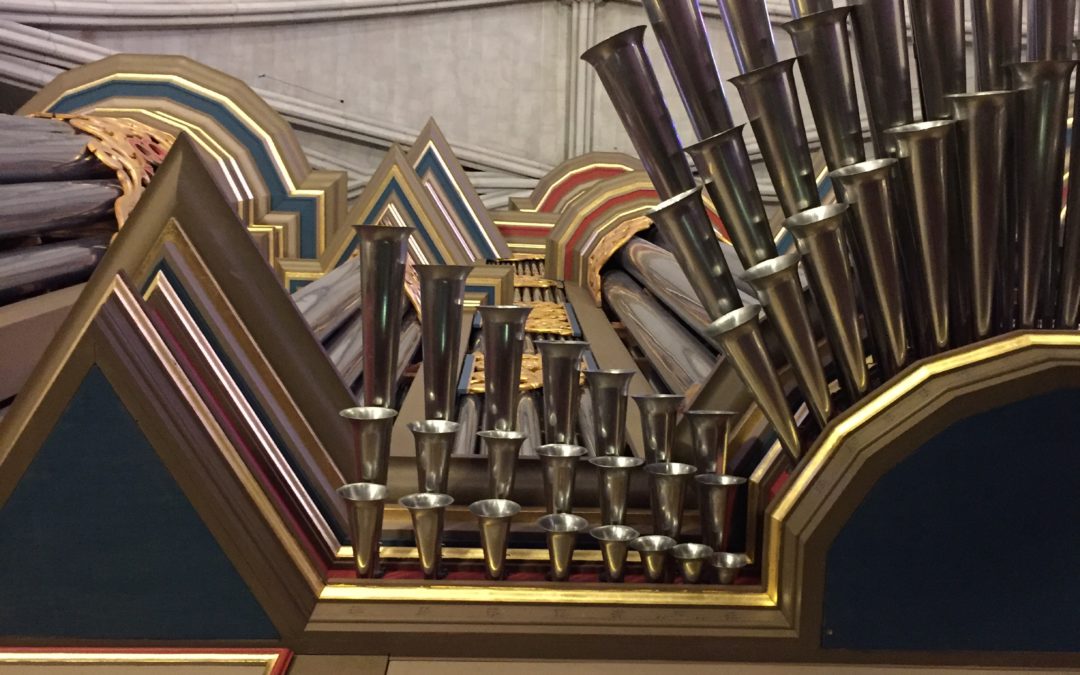
What stops do I use? Part 5, Solo Stops and Novelty Gadgets
Now that we have been through the basics of organ registration, we can talk about the more unusual stops on the organ, including the solo stops, the stops that imitate orchestral instruments, the chimes, the harp, the celesta, and the stops that are there for sound effects.
A solo stop refers to any rank of pipes that is intended to be used by itself, soloed out in a single line, with the other hand in accompaniment and (if needed) the pedals offering a supporting line to the accompaniment. Solo stops can be a single rank or combinations of ranks that can be used for this single line of music. To that end, many of the ranks we have already discussed can be used in this capacity, such as a Principal 8′, an Oboe 8′, a Flute 8′. All that is needed is for the other hand/pedals to have stops that are slightly softer overall to be sure that the solo line is heard.
To discuss how to solo out a melody in repertoire, let us take one of the most beloved pieces in the Orgelbüchlein, BWV 599-645, (J.S. Bach’s settings of 45 chorale preludes for the organ). For most students of the organ, the first Bach piece they are assigned is the Ich ruf’ zu dir, Herr Jesu Christ, BWV 639. Bach did not put registration suggestions on his organ music, so the player needs to learn the basics of Baroque registration in order to play his music, and more advanced players study how to register Bach pieces specifically. For most of us in the United States, organs have been built to play a wide variety of literature and service music from different time periods and regions of the world, but it is possible to effect a basic Baroque registration on almost any organ you have the honor of playing.
On a small two-manual organ, it is quite lovely to play this on the Great Principal 8′ for the right hand, and the Swell 8′ and 4′ flutes for the left hand, and use a light 16′ and 8′ for the pedal. That uses the Principal 8′ as the solo stop, although technically we would not refer to a Principal as a solo stop.
For a small, two-manual organ with a Swell Oboe 8′, you can use the Oboe for the right hand, and use the Great Flute 8′ for the left hand, same pedal. The Oboe is usually referred to as an ensemble reed, but is frequently used as a solo stop. If you have a larger instrument, you might use a stop called a Cornet, against the Swell Flutes 8′ and 4′. Here is such a rendition.
The picture below shows yet another alternate spelling for the Oboe/Hautbois/Hobo stop. And right next to it is the next stop you can read about, the Vox Humana. I must admit, the Vox Humana is a stop I have rarely used. It is frequently encountered in the organ music of César Franck, repertoire that my hands are too small to play without rearranging quite a few of the notes. It is intended to sound like the human voice singing. The Vox is not used the same way other solo stops are, to solo out one line. Instead, it is used homophonically, and usually with an 8′ flute paired with it. So if you imagine a hymn played on an 8′ flute, all four parts, with a choir of four voices singing it, that might be a bit of what a Vox Humana sounds like. More or less. The last church I played in had one, but the tuner was always working so hard on other reed stops, he didn’t have time to tune it, so I rarely made use of it. I figured it was more important to get my human-voice choir to sing in tune than to worry about that human-voice stop on the organ.
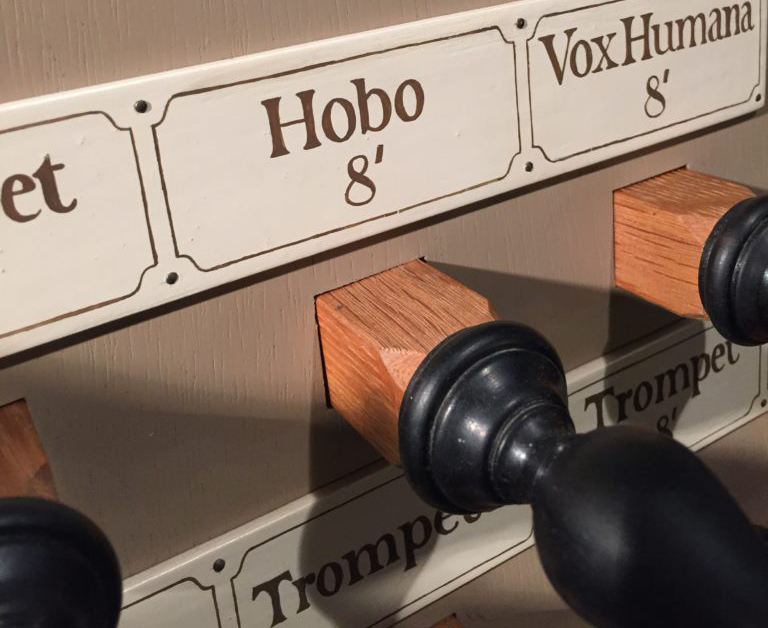
There are stops that are intended to be used only by themselves (such as the Vox Humana), and there are solo stops that can also be used in the ensemble (such as the Swell Oboe). The Harmonic Flute (usually found on the Great) on many organs is intended to be used as a solo orchestral stop, and most of the time you would not use it combined with other stops.
The picture below is of an 8′ Basset Horn, which I include here because 1) the picture is awesome (taken from the website of F. Booth & Son Voicers, Yorkshire, UK, and used here with permission), and 2) it is an example of the many varieties of stops and pipes you can find in a pipe organ. I don’t remember having the occasion to play an organ with a basset horn, but it serves as a great illustration of how varied and innovative organ building is all over the world. Depending on the instrument, it is likely that this reed stop could be used as a solo or ensemble reed.
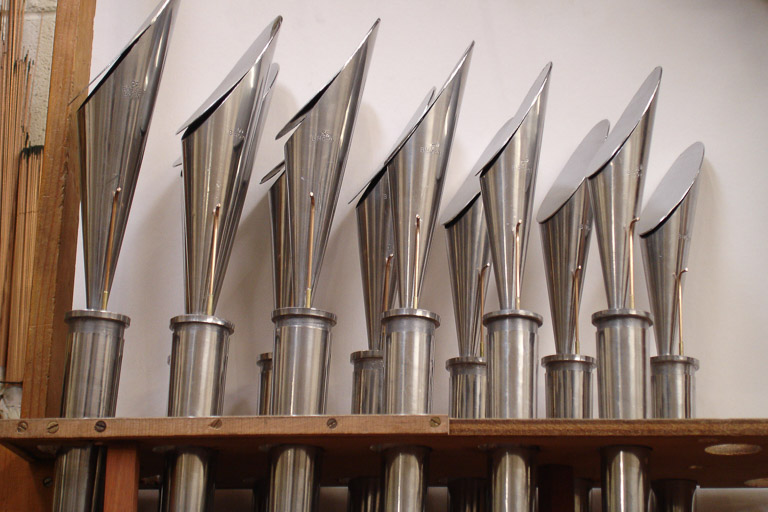
There are a multitude of solo stops that organ builders use when building their instruments, and to name just a few, they include the clarinet, English horn, krummhorn, and cornet (which has a number of ranks included in its composition).
One stop that falls into its own category is a Trumpet en chamade (see the featured image at the top of this post). These trumpets are very visible, jutting out horizontally from the case (so sometimes we call them the horizontal reeds, too) and striking in appearance as well as in sound and texture! They use very high wind pressure, and make a very piercing sound that can be heard over the rest of full organ. To this end I am putting it into the category of a solo reed stop, because if you play more than one note at a time on them, it can sound quite unpleasant (but that also depends on how loud the reed is, and how resonant your room is). This stop can be used for weddings to solo out a melody in place of a trumpet player, or to solo out the melody of a hymn on festival Sundays. However, they can be too loud for some, and I caution you to use them sparingly, (like hot sauce), and rarely play more than one or two notes at a time. Here is a perfect example, using the en chamade for the John Stanley Trumpet Voluntary.
As if all this wasn’t enough, organs have gadgets and fun things to play with. Most Americans know about the chimes, since they are used in many small instruments and indeed, the Möller organ I learned on had a set of chimes, usually used to mark a quiet moment in the service (such as a call to worship or as a communion meditation or some kind of prayer invocation). A church I played in recently had the organist play several notes on the chimes to notify the bridal party that it was time for the groomsmen/clergy to come out before the processional. When I was a child, the organist at our church played the melody of a quiet hymn on the chimes, the alto and tenor in the left hand, and the bass in the pedal. I think that was what she did for every communion meditation.
The Celesta is a different stop entirely, intended to replicate the same sound as the celesta in orchestral music. (Anyone who has heard Tchaikovsky’s Nutcracker Suite has heard a celesta.) It has also been called for in organ repertoire, most notably the Cortege et Litanie by Marcel Dupré. Interestingly, that performance, by Dupré himself, doesn’t use the Celesta, but uses his other option, a Principal 8′. Organs make use of harp and celesta stops for effect (and also for fun). The celesta is not to be confused with the celeste, which will be discussed in Part 7. The harp is basically the same as the celesta, which is pitched an octave higher than the harp. The last organ I had did have a harp, and the only thing I ever used it for was to demonstrate it as a novelty to people who visited and had never seen a pipe organ.
The possibilities of exotic and unusual sounds abound in pipe organs. In addition to different sounds, it also includes novelty stops, notably the Zimbelstern and Nightingale. Of these two, the Zimbelstern is most common in the United States. Most of the time it is visible as a star placed high on the organ case, and includes a set of bells that ring in a circular motion. It is fun to use this during dance-type Baroque pieces, or at any moment when adding a set of bells would add to the festivity. They don’t add enough pitch to distract from the tonality you are playing, more like having structured wind chimes playing.
If you have visited Europe and its magnificent old Cathedrals and churches, you may have seen organs with elaborate organ cases with pipes that are decorated, and gorgeous wooden carvings. It is not uncommon to see faces looking down at you. Most of the time they are there to add to the design of the case, but in some older German churches, one might find that the faces move! However, that tidbit doesn’t add anything to my discussion of organ registration. I do digress!
The last thing I will mention is the Nightingale, which uses two or more pipes submerged in water or oil which makes a gurgling sound to replicate birds warbling. I’ve never played an instrument with a Nightingale, but it adds to the mystique of the organ, and is a fitting end to this discussion of the pipe organ and its solo stops and other effects. If you are interested in discovering these effects for yourself, a simple Wikipedia search will lead you into a multitude of directions, and further and further into the world of the pipe organ.
What’s next: Mutations and Mixtures, Part 6
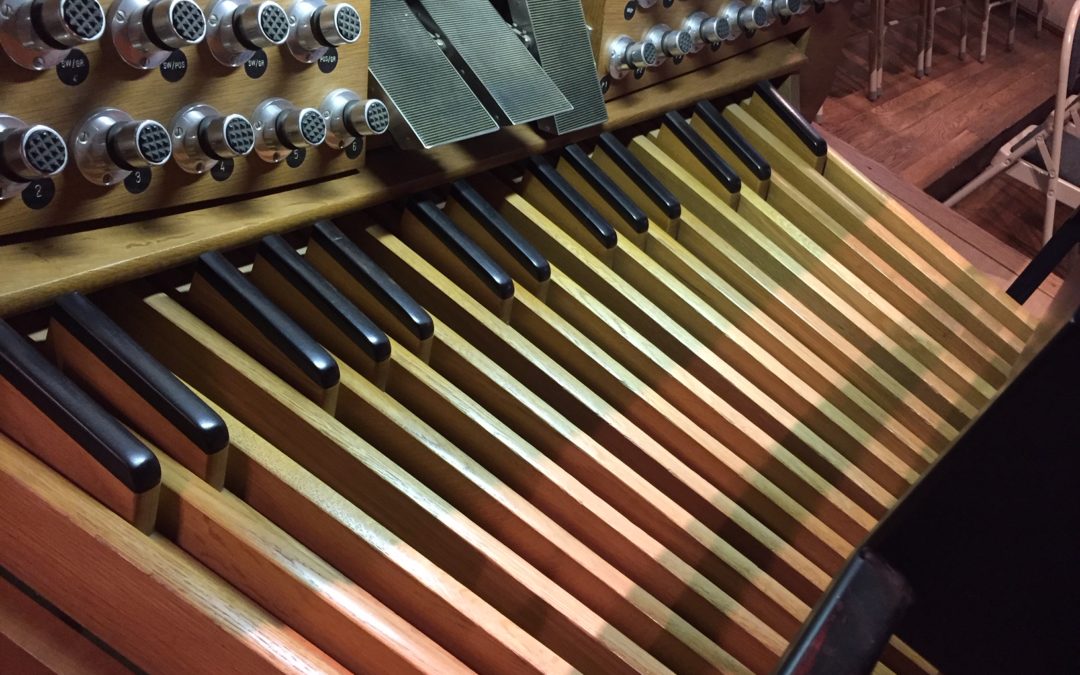
What stops do I use? Part 4, Basics of pedal registration
How exciting! If you are reading this blog post, that means you are either an organist who already plays the pedals, a newcomer who is interested in playing the pedals, or perhaps you are just interested in the organ! Thank you for reading, and for following this series of posts on how to register the organ. The Basics of pedal registration follows closely on What stops do I use? Part 3, which discusses how to use couplers. If you haven’t read it already, please do so for a preliminary discussion on how to register the pedal division.
If you are new to the organ it can be overwhelming to work with all the stops and buttons, but in my mind, that’s what makes it fun. Depending on how many ranks of pipes your instrument has, there can be rows of stop knobs, or perhaps a smaller, more intimate instrument. Whatever instrument you have, this post will cover the basics to get you started, and give you ideas to build on.
The first thing to do when registering the pedals is acquaint yourself with all the 16′ and 8′ stops you have available for the pedal. The 8′ stop on any division (meaning the keyboards or the pedal) corresponds to the pitch on the piano, so if you draw a 16′ stop, it means that the lowest pipe in that row of pipes is 16′ long, and plays the pitch that is an octave below the piano pitch. So using a 16′ will give you a lower octave than you can play with your hands, and adds a satisfying bass resonance to whatever you are playing. So, just draw all the 16′ and 8′ stops you have and play each one by itself for a phrase or two.
The pedal division will be built on a Principal sound, and usually you will have a rank called Principal 16′ or Diapason 16′, so don’t be deterred by the different nomenclature. This rank of pipes is usually the loudest 16′ you have, and the others with that same number are usually either similar in volume (on a big organ), or they get progressively softer depending on how they are scaled or what material they are made out of. But if you are new to the organ, most of the time all you will need is your 16′ Principal for a loud hymn or postlude in contrast to your 16′ Bourdon or Gedeckt (a flute stop) for softer hymns and preludes, meditations or choir accompaniments. If you know the difference between those two 16′ stops and when to use them, that’s a great beginning.
Both of those ranks should have a corresponding 8′ stop of the same sound, so a Principal 8′ plus a Gedeckt or Bourdon 8′ (again, there are different names between organ builders and organ types). So, for a louder hymn you would use the Principal 16′ and 8′ (with a manual or two coupled down to the pedal) and for a softer meditation or choir accompaniment you would use the Bourdon 16′ and 8′ with the Swell coupled down.
But, here’s where it gets murky….for a louder hymn it’s perfectly acceptable to keep those Bourdon 16′ and 8′ stops on with the Principals. They don’t add much in volume, but depending on the acoustic in your room or the sound you are looking for, they can help to round out the sound in a very pleasing way.
For service playing and for most repertoire that you would use for a liturgy, knowing how to use the 16’s and 8’s from the pedal division, and knowing how and when to couple from other manuals is essential. Beyond that, we get into more in-depth subjects such as how to register repertoire from the different style periods, and how to register the organ for a festival service.
If your instrument is just a bit bigger, you will (hopefully) have a 32′ pedal stop on the pedal division. A 32′ stop sounds two octaves below piano pitch. Depending on the size of the church and the organ chambers, that 32′ may or may not be actually 32′ long at the lowest pipe. If the chamber is cramped for space, builders will use a 32′ resultant, which is actually two pipes programmed to sound together to artificially create the sound a 32′ pipe would make. Read here for more information on resultants. Given that the sound is very, very low, adding depth and resonance, using a resultant instead of an actual 32′ pipe is not easily discernible to the ear and thus is a great alternative to cramped space.
How do you use a 32′ stop? If you are lucky enough to have them, they are loads of fun. Organs can have as many as three 32′ stops, depending on the size of the instrument, and if you have one only, it will be a 32′ flue, which will be the softest. It will usually be called a 32′ Bourdon. Use this one for the end of lovely, quiet pieces or improvisations, or throw it on the last stanza of a hymn accompaniment. If you have two, the second one will probably be a 32′ Principal. This one will add more oomph to the end of a festival hymn stanza, and depending on how loud the 32′ Bourdon is, you might use them together, or just the 32′ Principal. Lastly, large instruments will have a 32′ reed stop, usually called a Bombarde. Save this one for only the most triumphant of hymn registrations, or at the end of your brilliant Easter postlude. It generally shakes the insides of anyone (usually a choir member) who might happen to be sitting near it in the choir loft. It can be really satisfying to bring on a 32′ reed on the very last pedal note of a piece.
Lastly, you might wonder HOW to bring these 32′ stops on. Most of the time you can set it on a last-stanza piston, but if you want to bring it on at another time you can either draw it by hand, or have a pedal divisional piston to bring it on just before a final chord. These pedal pistons are called toe studs, because you activate them with your foot. Most pedal toe studs are located on the bottom row of toe studs to the right of the crescendo pedal, and you can see them in the picture at the top of this blog.
Once you have explored the 16’s, 8’s and any 32′ stops you have, the rest of the pedal stops are usually a 4′ Octave, possibly a 4′ flute, oftentimes a Mixture rank and then the pedal reeds. The 4′ Octave will add clarity to the line, and usually used if you are using something higher in the keyboard, such as a 2′ or a Mixture. A 4′ flute is not used as often in repertoire or in hymn playing, since it is soft and doesn’t add much to the overall sound. A Mixture in the pedal is helpful for Baroque music and other types of repertoire specified by a composer, but in general, I use pedal Mixtures rarely, if at all. Mixtures are difficult stops to keep in tune, and coupling down to the pedal from either the Great or the Swell is usually enough.
The pedal reeds, though, are wonderful to have. They are (basically) grouped into two categories….the Bombardes, or Trumpets, and the Fagottos/Bassoons/Oboes. The Bombardes will be louder, and used for louder pieces or hymns, the Fagottos will be helpful for lighter registrations or Baroque Preludes and Fugues. The larger the instrument, the more pitch levels will be available for these reeds (32′, 16′, 8′, 4′) that can also be used as solo sounds, especially the 8′ and 4′ stops.
These days most composers give explicit registration instructions at the beginning of each piece, which helps you when working on the registration for your instrument. It is wise to consider these suggestions as starting points, since there are so many varieties of organ, and every instrument and placement in the room and acoustic is different, meaning that one cannot simply draw the suggested stops and play without adjusting.
One very common registration used in repertoire, especially in Bach, is for the pedal to have the solo line, either at 8′ or 4′ pitch. One example is his Wer nur den lieben Gott lässt walten, BWV 647 in the Schübler collection. To register this piece, play the left hand on the Swell with a light 16′ Bourdon, an 8′ Bourdon and a 4′ Flute, then use an 8′ and 4′ Flute for the right hand on the Great or Choir, then the solo on a 4′ Octave or 4′ Clarion in the Pedal. Listen here.
Lastly, the pedals can be used for players with small hands, like myself. In some pieces the range of the hands is too great for me to reach, so I couple down the manuals I am using to the pedal, and do not draw any pedal stops. This enables me to be able to use my feet for notes I cannot reach. One piece I do this on is the Brahms Es ist ein’ Ros’ entsprungen, No 8 in his Eleven Chorale Preludes for Organ, Opus 122. Listen here.
I hope this basic discussion of how to register the pedal division has been helpful to you. If you have other questions, please email me at Ask a Question!
What’s next: Solo Stops and Celestes, Part Five
(If you missed any previous posts in this series please visit the Pulling Out All the Stops page–they are all there!.)
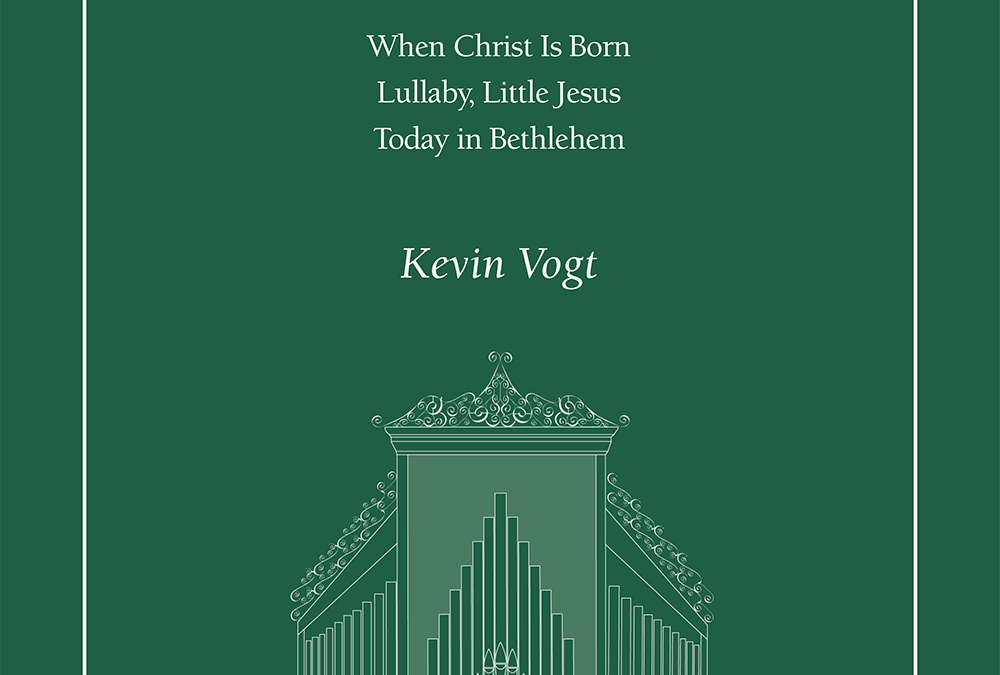
Christmas Music for Organ
Christmas just sneaks up on me every year. I’m not very good at planning in advance, and when I do get the gumption to plan things way ahead, by the time my choices come up, I frequently decide to do something else. What seemed perfect in late September just doesn’t quite feel right in December. (At least that’s my excuse.)
So this blog post early in December is a bit late for those of you who have already planned what keyboard music you are playing for Advent, Christmas Eve and beyond. But if you haven’t, here are some ideas!
There are certain pieces that I always play for Advent, which is a season I love (just like Lent), so planning my organ music for Advent usually begins around the following three pieces. First is J.S. Bach’s Wachet auf, ruft uns die Stimme (Wake, awake, for night is flying) BWV 645, from his collection known as the Schübler Chorales, (named for the editor who worked with Bach to organize the collection). For those of you who are new to the organ and to playing the pedals, this piece will be tricky, but well worth it. Another Bach piece that I love to play is his Nun komm, der Heiden Heiland (Savior of the nations, come) BWV 659. Both these chorale preludes are found on the IMSLP site, available for free download, but be sure to click through all the available editions before printing out one you like. Some are easier to read than others, and some still use alto and tenor clefs, making the music trickier to learn if you don’t play in those clefs regularly.
Johannes Brahms wrote a set of eleven chorale preludes, and his lovely Es ist ein Ros’ entsprungen (Lo, how a rose e’er blooming) is for manuals only. (My hands are small, though, so I have to couple the manuals down to my feet and pick up a few of the notes I cannot reach). Check it out!
During the Christmas season, I usually play one or two of the Noëls by Louis-Claude Daquin. All are available on IMSLP. There are twelve of them to choose from here, and most have very minimal pedal. They are also in segments, and I often don’t play the entire piece (okay, okay, I admit to sometimes leaving out the hard sections….)
If you’re like me, though, once you’ve scheduled your favorite pieces, there is usually room for some new music, or music you don’t play every year. GIA has some organ music for Advent and Christmas, if you are looking to expand your library, consider some of the following collections.
First, these collections are all settings of Christmas carols and tunes:
A Polish Christmas Triptych by Kevin Vogt
Seven Christmas Hymn Settings by Austin Lovelace
Ten Carols for the Christmas Season by John Kriebel
Six Carols of Christmas by Robert J. Powell
Three Hispanic Carols by George Lachenauer
A Wreath of Carols for Christmastide by Bernard Wayne Sanders
The following collections include pieces for the liturgical year, so each book will have an Advent and Christmas piece (or more) included in it:
Gregorian Preludes for the Liturgical Year by Kenneth Lowenberg
Ten Seasonal Hymn Tune Preludes for the Church Year by Robert J. Powell
Eight Hymn Preludes for the Church Year by Peter Niedmann
These collections also contain some tunes for either Advent or Christmas:
Eight Preludes for Organ on Familiar Hymn Tunes by Edmund B. Wright (setting of Picardy)
Fourteen Pieces for Organ by John McCann (settings of O Come, Emmanuel, Creator of the Stars of Night, The First Nowell)
Twelve Organ Preludes on Hymns Old and New by Paul Carlson (setting of Conditor Alme Siderum, Morning Star)
Six Hymntune Sketches for Organ by Anne Roberts (setting of Antioch)
Eight Hymntune Postludes by Adrian Mann (setting of Antioch)
Gathered to Worship, Volume 1 (settings of Conditor Alme Siderum, Es ist ein Ros’ Entspungen, Veni Emmanuel)
Ten Hymntune Preludes for Manuals only by Adrian Mann (settings of Hark! The Herald Angels Sing, Lo, How a Rose E’er Blooming, O Come, All Ye Faithful, What Child Is This)
Global Song Preludes and Intonations for Organ by William McNair (He Came Down, Une Jeune Pucelle)
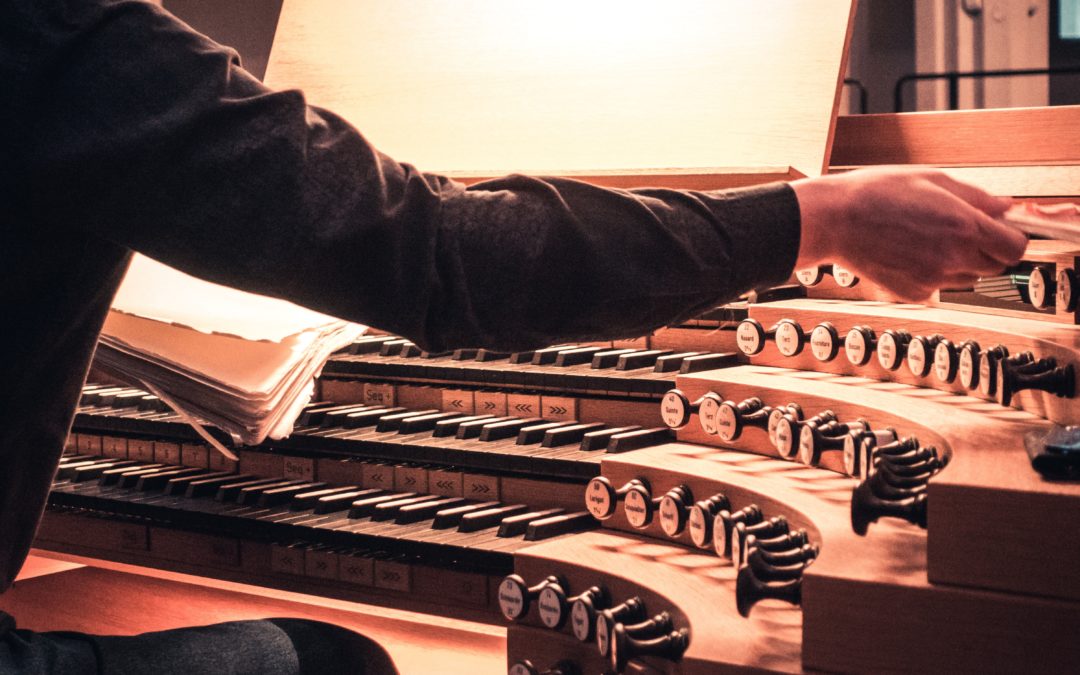
What stops do I use? Part 3, Using Couplers
- Using Couplers (Sw to Gt and Sw to Ped etc.) and when to do it
- Using Couplers and when not to do it
What is a coupler, anyway? The simple definition is that a coupler allows the player to link keyboards to each other, and to the pedal, so that all the stops drawn on the manual they are coupled from will also sound on the manual they are coupled to (or to the pedal). Couplers are most often tabs arranged in a row under the music rack, but can sometimes be arranged in the stop jambs as well.
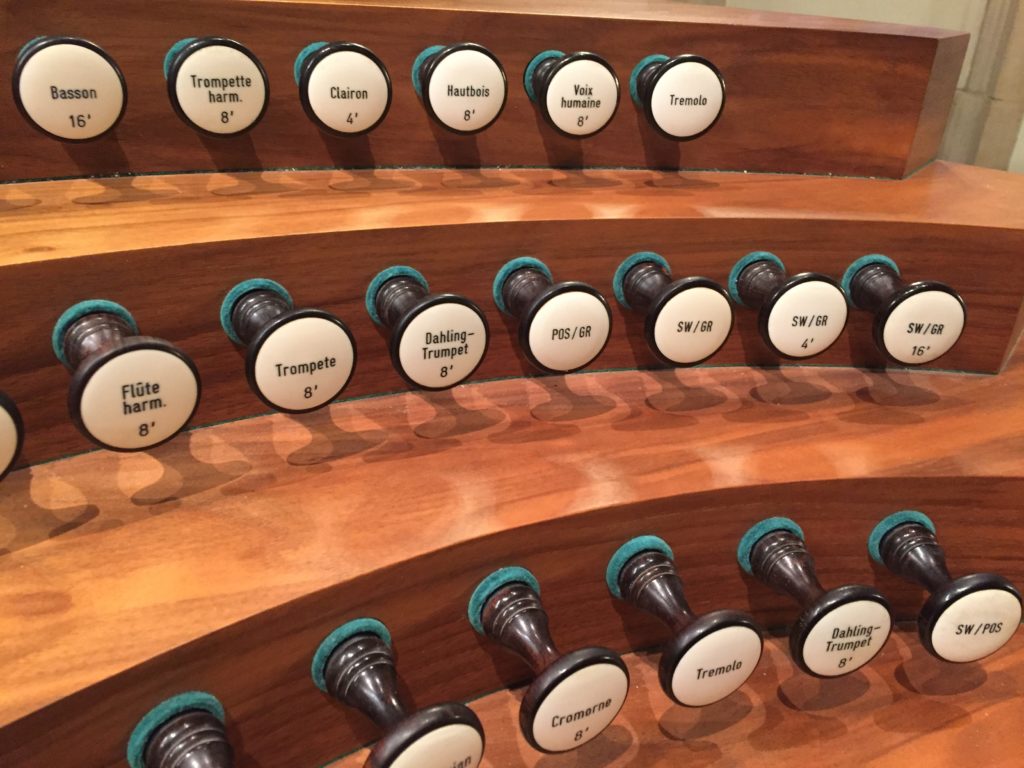
Each division of an organ (Swell, Great, Choir, Pedal, etc) has its own set of stops that sound when you draw them and play. Coupling them together gives the player more possibilities of sound, and most of the time and in most repertoire, couplers are used regularly.
Without getting into the complexities of couplers and how they are used in organ repertoire through the centuries, it might be best to discuss how they are used in service playing. Since my idea here is to give you basic information, overloading you with too much information in this short blog might not be helpful. So, for this article I will discuss how they work, and how to use them in hymn and service playing.
First, let’s use the three-manual organ as our template for today, with a Swell keyboard on top, Great in the middle, and Choir on the bottom. It is an electro-pneumatic organ (uses electricity to take the instructions from the keys/stops to the pipes), rather than a tracker organ, (which only uses electricity to provide the air into the organ and to work the lights at the console. The rest of the action in a tracker is provided by moving parts rather than by electrical impulse).
When playing a hymn, the Great manual by itself will probably need some filling out, so it is most common to draw stops on the Swell as well as the Great, and then use the Swell to Great 8′ coupler, to tell the organ to play all the sounds drawn on both manuals when playing on the Great keyboard. I usually draw the Swell to Pedal 8′ and the Great to Pedal 8′ as well. Most smaller to medium-size organs are built with the idea that you will couple down stops to the pedal, thus saving the organ builder room in the chambers, because large pedal stops take up a lot of room in the church! Plus, coupling the Swell and the Great to the pedal keeps the sound homogeneous, since you are bringing the sounds from both manuals to the pedal and adding 16′ stops to add a lovely bass sonority to the ensemble.
If you like, and if your organ has a Choir division, you may also draw some complementary stops on the Choir, and then couple the Swell to Choir for a verse or two that you would like to have in the same character but softer, keeping in mind that if you do so in a middle verse, you will need to take the Great to Pedal off and then put it back on again when you return to the Great, otherwise the pedal will not balance. Using the Choir to Pedal for a hymn registered this way is fine, but is usually not necessary, since the Swell and Great coupled to the Pedal will usually achieve the desired effect.
Therefore, for a festive hymn with multiple stanzas, you might draw the following registration:
Swell: 8′, 4′ 2′, Oboe or Trumpet, Mixture, Swell to Great. Great: Principal 8′, 4′, 2′, Mixture. Pedal: Principal 16′, 8′, 4′, Swell to Pedal, Great to Pedal
If the hymn is four stanzas, play the introduction and Stanza 1 on this registration, then a simple change would be to close the Swell box for stanza 2, and perhaps take off the Great Mixture. Open it for Stanza 3, and for Stanza 4, put the Great Mixture back on, add a 16′ Pedal reed if you have one and/or an 8′ Trompette to the Swell or Great Trumpet 8, or all of those if they sound good to your ear!
The above registration would work for festive service music as well, such as the Gloria or Holy, Holy. For more contemplative parts of the service, the following registration is suggested: Swell: 8’s and Flute 4′, Swell to Great; Great: 8’s; Pedal: 16′ and 8′ and Swell to Pedal, Great to Pedal.
Most repertoire that is published now includes detailed registration suggestions, giving the player information on what stops to choose as well as what couplers to use. All organs and acoustics are different, and registration suggestions are just that….suggestions. Nevertheless, they give the player a good starting place and show the composer’s intentions.
When not to use a coupler? Well, truthfully they’re used most of the time, especially in service playing. In repertoire they can be used very creatively, especially when you start using couplers that are not at 8′ pitch, such as the Swell to Great 4′. What I can say is that on most organs it’s best to avoid the sub and super couplers (Swell to Great 16′, Swell to Great 4′) and stick to the 8′ couplers until you’re ready to experiment with confidence.
The American Guild of organists has a video on using couplers which you can watch here.
I hope this helps to explain the coupling system a bit, and as always, if you have questions, Ask Marilyn!
(If you missed any previous posts in this series please visit the Pulling Out All the Stops page–they are all there!.)
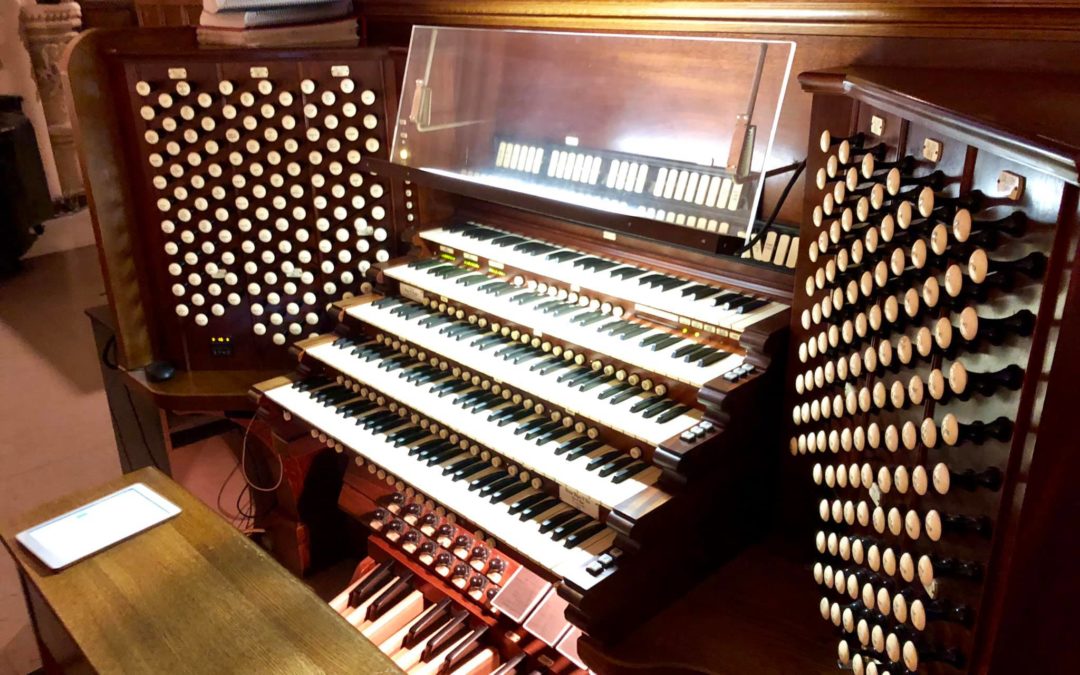
What stops do I use? Part 2, Principal Chorus, Strings, Flutes
- The Principal Chorus (If you can register one of these, you can get by!)
- Principals, Strings, Flutes, how/when to use each (and stay away from the reeds for now)
The easy part about this post is that there’s so much good information out there, and I can just point you in the right direction. The above bullets are points that Jennifer Budziak recommended that I talk about, for people who would like to learn more about registering the organ. So I’ll talk mostly about the basic sound groups on the organ in this post and leave the reeds for later.
In many ways the organ has similarities to an orchestra, with sounds that are named for, and sound like, orchestral instruments. The strings and flutes and reeds, for example, are built to sound as much like their orchestral counterpart as is lovely and right according to the organbuilder’s concept of the instrument. However, the foundation of the organ itself is built on an entire set of ranks called the principal chorus. (And here let me clarify that a rank refers to an entire row of pipes on the keyboard or pedalboard, so a Principal 8′, with 61 pipes, comprises one rank of pipes. A Principal 16′ in the pedal would have 32 pipes, one for each pedal.)
Here is a good explanation of principal stops, by Patrick J. Murphy and Associates Organbuilders. Once you can identify what the principal stops are on the instrument you are using, then you know how to pull out the principal chorus, which basically means one of each pitch level drawn and used together. Since the principal stops are the core of the instrument, then pulling them all together is the intention for certain kinds of repertoire, frequently in Baroque music, especially in Bach and Buxtehude. It is most common for a large pipe organ to have, on the Great, a Principal 16′, Principal 8′, Octave 4′, Quint 2 2’3, Octave 2′ and Mixture. Pulling all these stops at once is the principal chorus, also called the plenum, or organo pleno. Depending on the sound and volume you are after, you might not use the 16′, or the 2 2/3, so using the 8′, 4′, 2′ and Mixture is also acceptable.
If you are sitting at a console and aren’t sure which are the principals, there are two easy ways to figure it out. First, you can use your phone to Google the stop names in front of you to see what family of pipes they fall into. Second, stop tabs are always put in a certain order. When the stop tabs are in a row under the music rack, then from left to right the principals are first, followed by flutes and strings. Then that same order starts over at the next pitch level. On an instrument with stops that are vertical, on either side of the console rather than horizontal (such as the photo at the head of this post), the principals will be at the bottom, and the next row up will be a flute, then a string, and then it will start over. In that formation stops are placed in two or three rows, but if you look at the order carefully, you will see that they are laid out in such a way that it is easy to figure out the order. Keep in mind there can be exceptions, so when all else fails, Ask a Question!
The next main manual, the Swell, will also have a principal chorus. The Swell will start with a Principal 8′, and will (usually) have a 4′, a 2′ and a Mixture, depending on how much room is available in the organ chamber.
The next manual, if there is one, is the Choir or Positiv, and it will usually not have a Principal 8′ but will start with a Principal 4′. That means that the 8′ foundation pitches used in the Choir will be Flutes or lighter String stops.
But, all of this is subject to the available space in the church or hall, and the artistic vision of the organbuilder. For now, if you know that the Principal Chorus is made up of members of the same pipe family, and you learn how to use them together and how to mix them with other pipes, that’s a good start. In general, using the entire chorus together is for Baroque pieces that call for the entire plenum, but a skilled organbuilder also knows how to voice the principals so they can be used alone and in various combinations and in all kinds of repertoire.
The flute stops come in a lot of varieties, and are among the sweetest and loveliest stops available. Some of them are for ensemble use, and some make good solo stops. When accompanying a choir it’s good to combine various 8′ flute stops with some sprinkling of light string 8′ stops, which I will talk about next. A future post will describe how to combine stops from different manuals, but here I’m just talking basically about what the stops are and how you use them.
Read here for a definition of string pipes in general. Then, there are the strings, which produce a shimmering sound, much like the sound of a section of violins playing together. For this sound the builder takes one of the string ranks, most frequently in the Swell, and uses another rank of pipes next to it (which is not used for anything else) and tunes it slightly sharp. (It is called a celeste.) When you draw both stops at the same time the beat between the ranks causes a lovely, undulating sound. On bigger organs a flute stop may also have its own celeste. The celeste should not be drawn for anything else other than its partner rank, but that other rank can be used alone or in other combinations.
For more information on organ pipes, see John-Paul Buzard’s post on Organ Construction. Stop back for my next post, a discussion about Couplers – What They Are and When to Use Them!
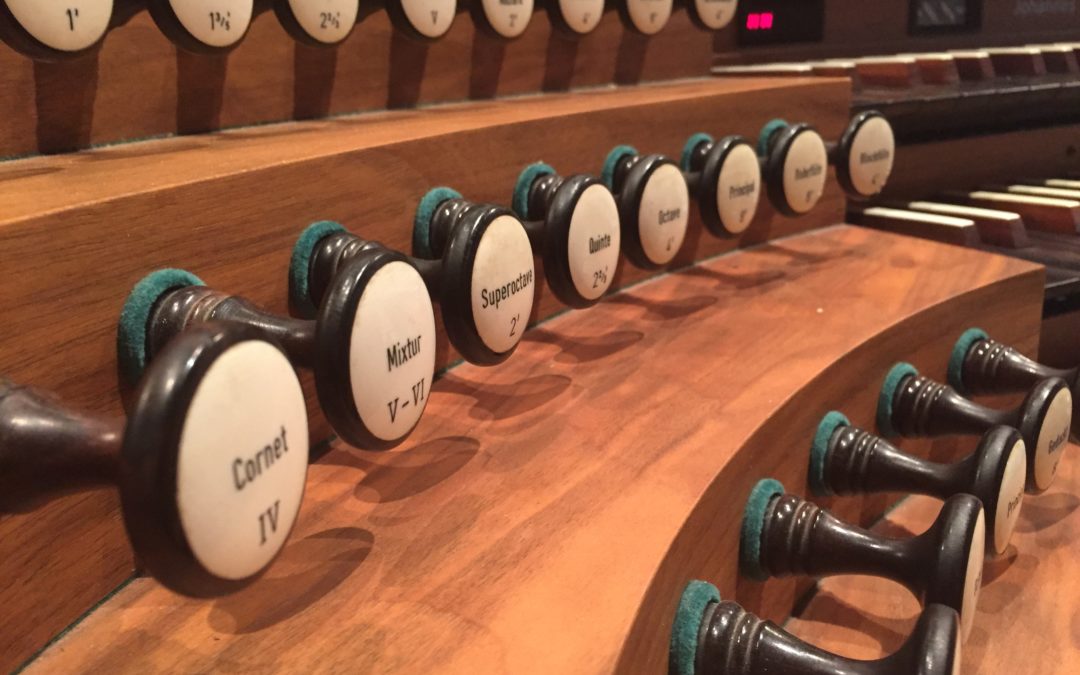
What stops do I use? Part 1, Getting Started
This is one of the questions most of us have, whether or not we studied the organ in college, privately, or are just interested in how it all works. I happen to be married to someone who sees all those knobs and buttons as a delightful opportunity to experiment. (Kind of like playing with LEGOs.) I, however, see all the knobs and buttons and I promptly go out for coffee while he figures out the organ and how to register it. When we were playing duet concerts we would walk in to a new church to start registering our pieces and he would sit down and joyfully get started. I saw that as my cue to tiptoe ever so quietly away and slink back an hour or two later. (Most of the time he wasn’t even aware that I had left.) Over the years I have learned to be less intimidated by the process, and even to be more daring and experimental, but it doesn’t come naturally. My goal here is to give you enough information to answer some basic questions, and to encourage you to read more in-depth information if you want to learn more about the organ. Most organbuilders have good, helpful information on their sites, and as usual, Google is a great place to start on your search.
The American Guild of Organists has videos on how to register the organ, and there is other information out there if you search for Organ Registration, but let’s start with some really great questions and subjects, suggested by a dear colleague and friend who shall remain nameless, but whose initials spell Jennifer Kerr Budziak. (Oops!) Jennifer’s questions will be spread out over the next six blog posts. If you have any additional questions, or think I’ve missed anything, please don’t hesitate to email me at Ask a Question.
What’s with the numbers? (8 and 4 and 2 and please don’t mess with the fractions just now.) Organ stop knobs have numbers on them, such as Principal 8′, Octave 4′, Doublette 2′, Oboe 8′, etc, to let you know at what pitch level the pipe will sound. An 8′ stop tells you that the lowest note on the keyboard, a C, plays a pipe that is 8′ long. From that 8′ long pipe the ascending pipes get smaller as you play up the keyboard. Any 8′ stop you choose on an organ will sound at the pitch that corresponds to the piano keyboard. There are, however, times when the length of the pipe is not what I just described. Stopped flutes are another example, as they start at 4′ length rather than 8′, but sound at the same pitch as an 8′ stop. Here is an explanation of how that works:
“Stopped flutes, (Bourdon, Gedeckt, Lieblich Gedeckt, Stopped Diapason, Flute d’ Amour) can be made of wood or metal. The stopper is inserted into the top of the pipe and forces the air column to return down the length of the pipe to create a distance twice as long as the physical length of the pipe.” (For more information on flute stops in general, visit the site this quote came from, Patrick J. Murphy, Organbuilders.)
A 4′ stop will sound an octave higher than the 8′, and thus a 2′ will sound two octaves above the piano pitch. Therefore, a 16′ pipe will sound an octave below, so the lowest C plays from a pipe that is 16′ long. Combining different pitch levels, along with different combinations of pipes (flutes, reeds, principals), will produce a fuller sound than a piano, more like an orchestra, where multiple instruments blend together. It also is an artificial way to produce more of the octaves found in the harmonic series.
Swell vs. Great vs. Choir. Each keyboard has a different name. Let’s get started with the easy one, the pedalboard. It’s always called the pedalboard, and it’s always in the same place! Organs have anywhere from one to five manual keyboards, and they usually go in a certain order. The first one is the Great manual, called so because it used to be the main stand-alone organ, centuries ago, before organs were all put together into one console. Before that practical invention, churches would have more than one organ, such as the Great, for loud sounds, and a smaller, more portable chamber organ to accompany soloists or the choir. Once somebody got the brilliant idea to put all the keyboards together in one console, it saved the organist a lot of running around, and also enabled more keyboards to be added, with more divisions (basically, more sets of pipes).
When there are two keyboards, the second manual will always be above the Great, and it is called the Swell. The Swell is usually enclosed in a chamber with shutters you can open and close with your foot (affecting how loud the pipes sound in the room), using a pedal that looks much like a car’s accelerator pedal. When there are three keyboards, the third manual is usually called the Choir, and will be placed below the Great, and usually is also enclosed in a chamber (sometimes that manual is called a Positiv).
These are the most common manuals organbuilders use, and they are generally used in that order unless the organ is historically reproducing something from France or Germany, but you don’t need to know that at this point.
Basically, the Great manual stops will be the loudest, used for full organ and thus for hymn registrations and repertoire that calls for more sound. The Swell will have a range of sounds from a smaller, lighter version of the Great manual to including more stops with color and bite, like the reed stops. The Choir manual can have a range of colors and sounds and frequently will include stops that are suitable for accompanying the choir, (usually Swell and Choir are mixed together for choir accompaniments) as well as more interesting solo stops.
I hope this brief tutorial will begin to explain some of the mysteries of organ sounds and registration, and that you will keep reading!
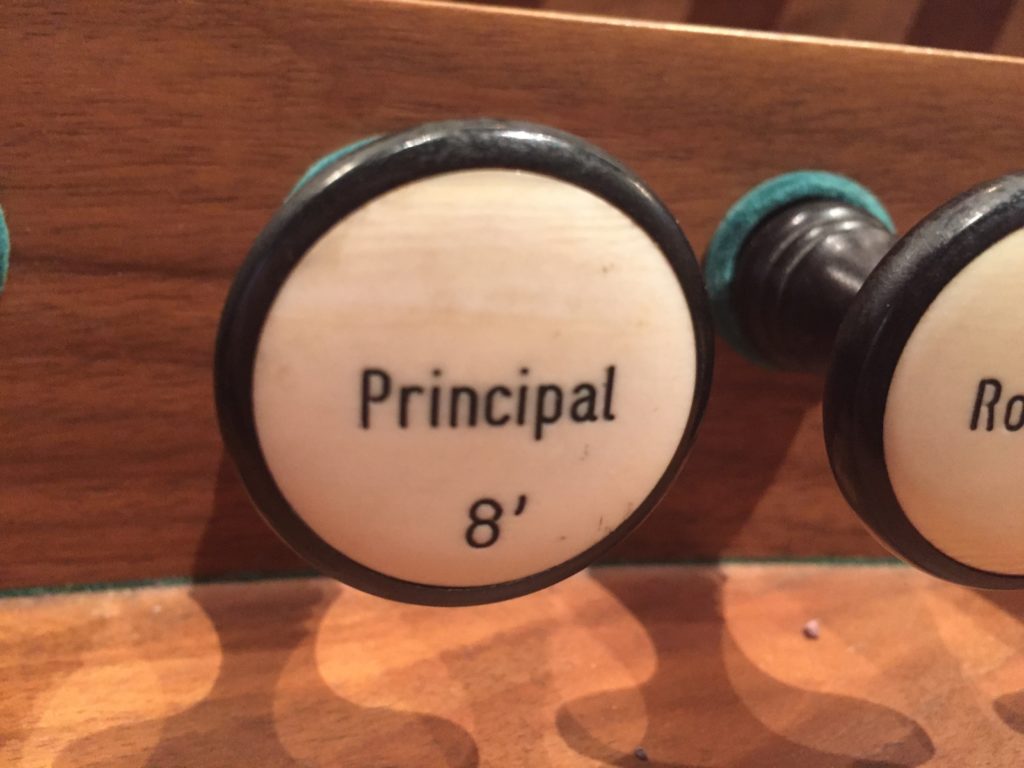
Coming next! Information on the Principal Chorus, Strings, and Flutes.

Let’s be Capricious, shall we?
Well, ok, I’ll admit, I’m not quite sure how being capricious fits in with organ music, but I’m looking to attract your attention.
It’s my hope to transmit my love of the organ and its repertoire to you, with the idea that you will become so smitten you will try it, too! The mighty organ, often called the King of Instruments, has of late become associated with music that is out of date and no longer in the mainstream of church music. It’s also often associated with scary movies and Halloween, but that’s fun and who would discourage that? But, I’m hoping to present a balance of good organ music that will delight you as the player, and your congregation as the listener. So, let’s have some fun, shall we?
First, just look at this picture of Louis-Nicolas Clérambault (1676–1749). He’s looking at us with a bit of a smirk, and his nose is crooked. Too many fights as a child? Certainly his music would be interesting, yes? Plus, he was from Paris. Need I go on? Clérambault was an organist and composer who wrote an amazing amount of music for the church, remembered today mostly for his organ music. His first Livre d’orgue (Organ Book) contains two suites of multiple movements, and our piece of the day, the Caprice sur les Grands Jeux, is the last movement of the second suite.
The practice of the time was for the title of the movement to tell the performer about the texture and the registration of the piece, hence titles like Fugue, Duo, Trio, or Plein Jeu, Flutes, or our movement, Caprice sur les Grands Jeux. French organs of the Classical period were very ornate, and the organ stops were colorful and the way to combine them was prescribed quite exactly. Thus, the organist would see the movement title and know what to draw on their instrument. For the Caprice, the Grand Jeux would have called for just what it sounds like, a large, grand registration with specific stops drawn. Today’s organs are more eclectic and it’s not always possible to get the same kind of sounds that the French composers were asking for. Still, it’s helpful to know the basics so that you can interpret the piece more or less in the style.
It’s amazing to be able to find answers to questions on the internet, and here is a good explanation of the Plein Jeu and Grand Jeu, as well as the difference between a Plein Jeu and Grand Jeu registration combination.
It makes my job so much easier to give you these links, and especially to send you to performances like this one. This is an authentic French instrument, so the sound is what Clérambault would have been expecting, plus the video of the organ case itself is great to watch. It’s faster than I would play it for worship, but it gives you one interpretation. Here’s another, the tempo of which I prefer, and the video is great because you can watch the organists’ hands, which tells you a lot about the articulation to use when playing it (fairly detached throughout). And here is a third performance, which demonstrates the use of notes inégales (basically, the practice of playing notes slightly unevenly, to effect a more elegant interpretation).
So, now that you’ve learned a bit about authentic performance practice for this piece by Clérambault, what does this mean for you as a musician for a Catholic liturgy or Protestant service? Well, my advice is to use it as a postlude, and draw a fairly full registration on your instrument, something like this: on the Great manual, a 16′ Principal if you have one, a Principal 8′, 4′, 2 and 2/3, 2′, and any Great reeds you might have, and any other mutation stops to add color. But if you’re playing a small organ with limited color, just draw what sounds good to you, like Principal 8′, 4′, 2 2/3, 2′, Mixture and Great Trumpet (or couple in a reed or two from the Swell manual). And if that doesn’t give you good ideas, just open the crescendo pedal until it sounds good!
So, I hope you give this piece a try. I’ve done two editions for free download. One is the original for organ, the other eliminates the pedal and makes it playable on manuals only or the piano. And if you have questions, email me and ask, please! I hope you play this piece! (and….let me know if you do, okay?)
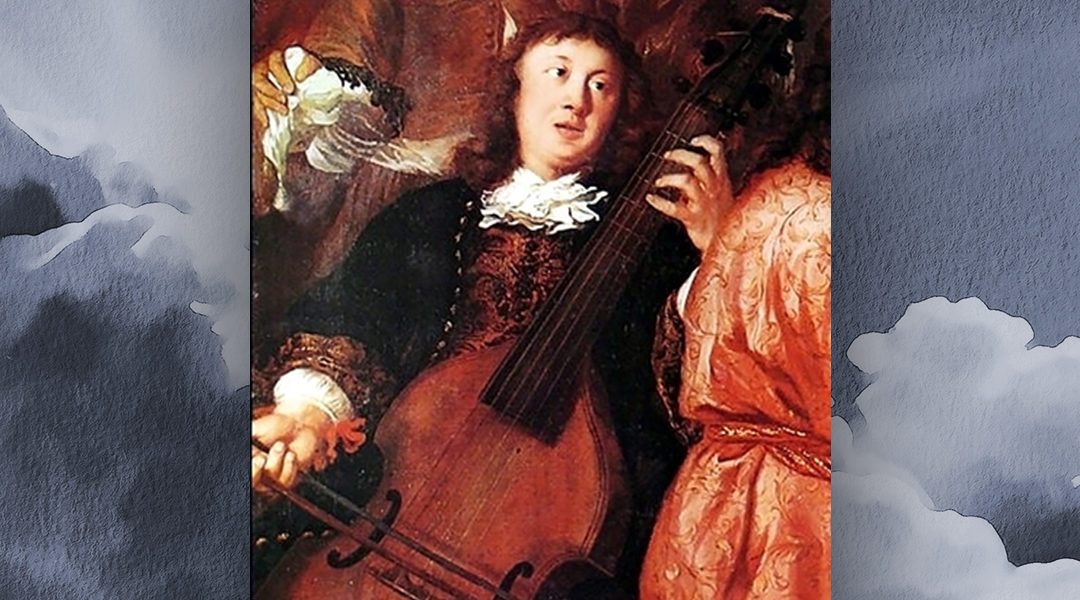
Dancing with Buxtehude
Three years ago I was lucky enough to go on a tour of Germany with a group of organ enthusiasts. The theme was “In the footsteps of Bach,” and we visited many of the churches and towns where J.S. Bach served, or that were significant to his life. Our first stop was the famed Marienkirche (St. Mary’s Church) in Lübeck, Germany, where Dietrich Buxtehude (1637/39-1707) was the organist. Buxtehude was well known throughout Germany for his Abendmusik (Evening music) at the Marienkirche, and in 1705 the twenty-year-old J.S. Bach walked 250 miles to spend some time with Buxtehude and attend some of his performances, receiving a leave of absence from his church in Arnstadt.
I always wondered about that visit…the walking, the length of time that Bach was away (which was longer than his church granted him), plus the fact that he was gone over Christmas. I think of the schedule most of us have in our churches and just the thought of being gone over Christmas brings on panic. But, he was young, he did it anyway, and he got into heaps of trouble when he got back. That visit made history, so there must be some kind of lesson to be learned from just doing what you know is right for you!
The organ loft at the Marienkirche was as inaccessible as any I have ever seen. There was a winding, slippery, cement staircase with no way of knowing how far it went up, and panic alcoves strategically placed along the way. (One person did use one of the alcoves, and promptly went back down, which was wise, as I discovered later.) Once we had gone up the many, many stairs, we found ourselves outside, on the roof! From there our guide led us into the attic, where we traversed a rickety wooden bridge that crossed over the entire roof of the Marienkirche (since we were in the attic, we weren’t out in the elements) through an itty-bitty door to the loft itself. Shades of Indiana Jones!
I have a fear of heights.
We got up to the loft and I immediately decided that I neither needed to look down over the rail, or sit at the console. I lasted a very few minutes only to decide that I had seen enough and I went back down the same way I came up (all alone, I might add) only to discover that a helpful docent had locked the door behind our group. And no cellphone service. In that small sacristy room I found the first person who had left us at the staircase, waiting at the same locked door. Well, we stayed there for a few minutes until my husband, James Biery, appeared (was I ever glad to see him)! He had tried to play the organ, but discovered his legs were too long and his knees knocked on the lowest manual, so he gave up and went looking for me. He looked around that little area and found another door, with a key hidden on the side of it. He figured out how to unlock it and suddenly we could see outside into the square. (BREATHE!!) Somehow, and my memory is hazy on this, I was coerced into being nominated to be the person to walk around and look for help. After walking a city block to get back into the Marienkirche, I found the disbelieving docent (who spoke little English), who didn’t quite buy my story about having been locked in that room, separated from our group. I convinced him by pointing to the loft, where he could see the rest of the group, and he was gracious enough to unlock the door so the others could get out when they came down, and we were all reunited.
So I think of Buxtehude, going up to the loft to play the organ there, and I’m amazed. Plus, there was no electricity! (And where would the nearest bathroom be?) Did he dance a jig up the stairs? But, I digress, and it’s time to talk about his music. In particular, I’d like to share with you my love for his Gigue (Jig) Fugue, BuxWV 174 in C Major. Let’s dance with Buxtehude, shall we?
Most of Buxtehude’s organ compositions are either longer, sectional works, or chorale preludes. The Jig Fugue is one of the few shorter works, about three minutes long. I have made an arrangement of the fugue that is available for free download from GIA. There is a version for organ, and a version for organ or piano for keyboard only, no pedal. The score I based the arrangement on was taken from IMSLP and you can find it here.
There are a few YouTube performances available, and this is one I like for style and tempo. Several of the YouTube performances I listened to have an F-sharp as the last note of measure 6, but I prefer the version in IMSLP, which has an F-natural, which you will find in my edition.
I have used this piece many times in worship, and it is always well received. It is a great summer postlude, or sprightly prelude, or second recessional for a wedding.
The basic registration for the fugue is to start by drawing the main 8′ stop on the Great, which is usually called a Principal or Diapason, but you can identify it fairly easily because it should be the loudest 8′ stop on the Great, not including any reed/trumpet stop. Then add a 4′ stop, usually called Octave 4′. A 2′ comes next, flute or principal will work just fine, followed by anything that is called a Mixture. Draw similar but lighter-sounding stops on the Swell, meaning an 8′ Principal, possibly skipping the 4′ and going right to the 2′, then a lighter Mixture or Plein Jeu or whatever your Swell Mixture is called, or possibly just a 1 1/3 on the top instead of a Mixture, depending on what sounds right to you. Use any 16′ pedal stop, probably the Principal 16′, and the Great to Pedal coupler and you’re good to go. The score has places indicated where you leave the Great manual to go to the Swell and back again if you choose, or you can skip the Swell entirely and just play on the Great throughout. When you do go back to the Great, or if you just stay on the Great, you can add something in measure 50, either the Swell to Great or a Trumpet on the Great. Again, experiment and trust your ear.
The last beat of measure 64 is another place you can add something for either volume or brilliance, if you didn’t do so in measure 50. Since you aren’t playing with your feet at this point, you can set one of the pistons ahead of time, and hit the toe stud with your foot, or you can draw the knob with your hand, whichever is easier for you. You can add the Swell to Pedal at that point, and any 16′ reed in the pedal that will make the pedal line stand out. Measure 76 is a place where you can pause for effect and add a ponderous 16′ Reed stop to the pedal, if you have one, or couple something down from another manual. All organs are different, and what works on one instrument may or may not sound good on another, so experiment, experiment, experiment!
I have also heard this piece played on flutes only, either 8′ and 4′ or 8′ and 2′. While it is helpful to have a sense of what would be customary, it is also just fine to register it however works for your instrument, and for the occasion. The only thing to avoid is using the voix celeste, or as a general rule for the Baroque style, putting on more than one stop at each pitch level. Also, since it has a dance-like quality, full organ is probably not the best choice (until the last two measures, then have fun!).
Baroque performance practice calls for a piece like this to be played mostly detached, with an emphasis on the main beats. On the organ this is achieved by lingering on the strong beat a little, on the piano you can accent the note. This is where YouTube recordings are so helpful, as you can listen to a number of different interpretations and decide what works well for you on your instrument and in your acoustic. I’ve never played this piece on the piano, but after editing the last bars somewhat to eliminate the pedals, I think it would work just fine and be useful either on the piano or on an organ without pedals.
For those of you who are new to playing pedals, this is a great piece to get started with. Most organists wear organ shoes, but truly, it’s not going to be an issue in this piece and if you are jumping from keyboard to keyboard at your church for a liturgy, just walk from the piano over to the organ and either play in whatever you have on, or slip off your shoes for this piece. Personally, I like organ shoes because they have the right fit and feel, with a one-inch heel. Plus, wearing only organ shoes to play in will cut down on dirt, grit or mud/snow on the pedalboard from street shoes or puddles on the floor during winter or other inclement weather.
I have indicated pedaling for the end of the fugue, which ascends up a C-major scale and can be played all detached, as would have been the style. Pedalboards in Buxtehude’s day were not concave as they are on most organs today, and simply using the left foot for most of this ascending line would have been in the style. The arrow marking under the note indicates to play with the left foot, above the note indicates the right.
I do hope that you use and enjoy this piece, whatever version works for you, or perhaps both! If you have any questions, feel free to email me at the Ask a Question button on the main blog page. Enjoy dancing with Buxtehude!
Why Do We Sing?
By: Diana Kodner Gokce
Explore Sing Amen
Looking for more great resources, articles, podcast, and more throughout all Sing Amen blogs? Search through the site here.
Search By Category
Search Archives
